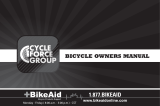Page is loading ...

26
ASSEMBLY
Forks
There are two different types of forks that range in styles and dimensions.
One type is a rigid fork (Figure 1) consisting of stationary tubing with
curved blades. The other type is a suspension fork (Figure 2) consisting
of stanchion tubes riding on elastomers or springs inside of a straight fork
leg. This mechanism acts as a shock absorber with a specified amount
of travel that varies between models. Some suspension forks are not
adjustable and are very difficult to disassemble. If service is needed on a
suspension fork, consult a professional bicycle repair technician.
Do not attempt to disassemble a suspension fork yourself.
Consult a professional bicycle repair technician.
Check the tightness of the headset and the fork. Rotate the fork checking
for smoothness. If it feels like the fork is binding, then an adjustment will
need to be made to the headset. Move the fork in a push/pull manner
checking for tightness. If any play is detected, loosen the top nut,
adjust the bearing cup, and retighten the top nut. Recheck the rotation
and tightness. If necessary, readjust until a smooth rotation is achieved
without backward or forward movement. If your bike is equipped with a
suspension fork, check that the fork compresses and rebounds smoothly.
To do this, place the fork dropouts against the ground, push and release
the handlebar. The fork will generally compress 1-2” and rebound quickly.
Most elastomer type forks will gradually soften with use.
Steering Tube
Crown
Brake Boss
Blade
Drop-out
1
Steering Tube
Brake Boss
Fork Blade
Drop-out
Brake Bridge
Crown
2
/




